Around the World
January/February 2021
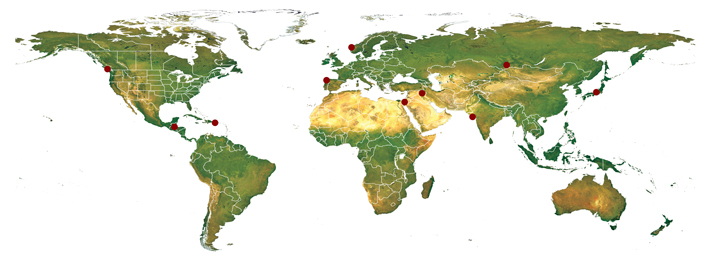

-
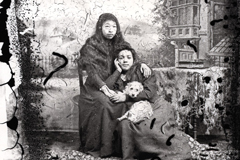 CANADA: Domesticated dogs have played an integral role in Indigenous life for thousands of years, used for transportation, hunting, and protection. First Nations archaeological sites throughout the Pacific Northwest in particular contain plentiful remains of a special type of woolly dog. These small canines were prized for their coats, which were sheared like sheep pelts. The wool was then used to create blankets, garments, and belts. The dogs are believed to have gone extinct after European-made textiles became widely available.
CANADA: Domesticated dogs have played an integral role in Indigenous life for thousands of years, used for transportation, hunting, and protection. First Nations archaeological sites throughout the Pacific Northwest in particular contain plentiful remains of a special type of woolly dog. These small canines were prized for their coats, which were sheared like sheep pelts. The wool was then used to create blankets, garments, and belts. The dogs are believed to have gone extinct after European-made textiles became widely available. -
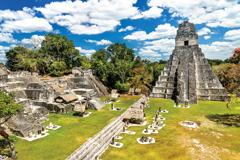 GUATEMALA: Some 2,000 years ago, the Maya inhabitants of Tikal struggled to consistently access clean drinking water. To solve this problem, they created an ingenious water purification system using the minerals quartz and zeolite. It is the oldest of its kind in the Western Hemisphere. The minerals were obtained from a source 18 miles away and brought to the Corriental Reservoir outside the city, where they were used to filter out harmful microbes, heavy metals, and other toxins.
GUATEMALA: Some 2,000 years ago, the Maya inhabitants of Tikal struggled to consistently access clean drinking water. To solve this problem, they created an ingenious water purification system using the minerals quartz and zeolite. It is the oldest of its kind in the Western Hemisphere. The minerals were obtained from a source 18 miles away and brought to the Corriental Reservoir outside the city, where they were used to filter out harmful microbes, heavy metals, and other toxins. -
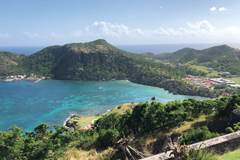 CARIBBEAN: For decades it was believed that the Caribbean islands were settled in a stepping-stone fashion by Amerindians migrating from South America. After reviewing 2,500 radiocarbon dates from 55 islands, researchers are now telling a different story. While Trinidad, the closest island to South America, was the first to be settled, 7,000 years ago, humans didn’t simply jump to the next island. Instead, they rode currents north across open sea to Puerto Rico, Cuba, and Hispaniola, before journeying back southward thousands of years later via a chain of smaller islands.
CARIBBEAN: For decades it was believed that the Caribbean islands were settled in a stepping-stone fashion by Amerindians migrating from South America. After reviewing 2,500 radiocarbon dates from 55 islands, researchers are now telling a different story. While Trinidad, the closest island to South America, was the first to be settled, 7,000 years ago, humans didn’t simply jump to the next island. Instead, they rode currents north across open sea to Puerto Rico, Cuba, and Hispaniola, before journeying back southward thousands of years later via a chain of smaller islands. -
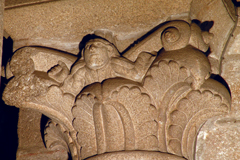 SPAIN: For the past 800 years, millions of pilgrims have journeyed to the Cathedral of Santiago de Compostela. Very few, if any, have noticed a quirky feature on a column tucked away in a dark corner 40 feet above the cathedral’s floor. It appears that an anonymous medieval stonemason cheekily carved a small self-portrait into the building. Probably intended as an inside joke to be seen by his fellow artisans alone, the 11-inch-tall figure was only recently observed.
SPAIN: For the past 800 years, millions of pilgrims have journeyed to the Cathedral of Santiago de Compostela. Very few, if any, have noticed a quirky feature on a column tucked away in a dark corner 40 feet above the cathedral’s floor. It appears that an anonymous medieval stonemason cheekily carved a small self-portrait into the building. Probably intended as an inside joke to be seen by his fellow artisans alone, the 11-inch-tall figure was only recently observed. -
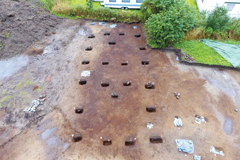 NORWAY: Prior to the construction of a housing development near Ørsta, archaeologists uncovered traces of a Viking-era temple dating to the 8th century. This “god house,” where deities such as Odin, Thor, and Freya were worshipped, is the first of its kind ever found in Norway, although examples are known from Sweden and Denmark. The building, which originally measured 45 feet long and 40 feet tall including its central tower, would have been the focus of rituals and sacrifices, particularly during the winter and summer solstices.
NORWAY: Prior to the construction of a housing development near Ørsta, archaeologists uncovered traces of a Viking-era temple dating to the 8th century. This “god house,” where deities such as Odin, Thor, and Freya were worshipped, is the first of its kind ever found in Norway, although examples are known from Sweden and Denmark. The building, which originally measured 45 feet long and 40 feet tall including its central tower, would have been the focus of rituals and sacrifices, particularly during the winter and summer solstices. -
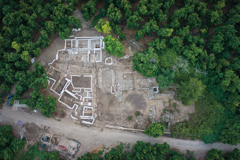 ISRAEL: The abrupt end of the Bronze Age site of Tel Kabri has long puzzled archaeologists. The Canaanite settlement was one of the most prosperous in the region between 1900 and 1700 B.C., before it was suddenly abandoned. New clues as to what might have happened were recently found during investigation of a 100-foot-long trench that traverses the site. The ditch was originally thought to have been a modern intrusion, but new analysis indicates that it is actually a rupture formed during a massive ancient earthquake that probably left the city irreparably damaged.
ISRAEL: The abrupt end of the Bronze Age site of Tel Kabri has long puzzled archaeologists. The Canaanite settlement was one of the most prosperous in the region between 1900 and 1700 B.C., before it was suddenly abandoned. New clues as to what might have happened were recently found during investigation of a 100-foot-long trench that traverses the site. The ditch was originally thought to have been a modern intrusion, but new analysis indicates that it is actually a rupture formed during a massive ancient earthquake that probably left the city irreparably damaged. -
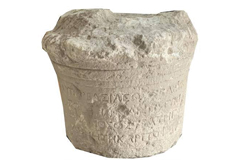 IRAQ: A stone pillar bearing an ancient Greek inscription was unearthed in the hills of Iraqi Kurdistan west of the city of Duhok. This territory became part of the Hellenistic world after Alexander the Great defeated the Persian army of Darius III at the nearby Battle of Gaugamela in 331 B.C. The 4-line inscription makes reference to Demetrius I, who reigned over the Seleucid Empire, which ruled the area from 161 to 150 B.C.
IRAQ: A stone pillar bearing an ancient Greek inscription was unearthed in the hills of Iraqi Kurdistan west of the city of Duhok. This territory became part of the Hellenistic world after Alexander the Great defeated the Persian army of Darius III at the nearby Battle of Gaugamela in 331 B.C. The 4-line inscription makes reference to Demetrius I, who reigned over the Seleucid Empire, which ruled the area from 161 to 150 B.C. -
 INDIA: One of the keys to sustaining the flourishing civilizations of the Indus Valley may have been the development of dairy production. Isotope analysis of lipid residues from ceramic vessels found at the site of Kotada Bhadli indicates that around 2500 B.C., dairy products were common there. This is the earliest such evidence known in India. Milk and cheese from domesticated cattle and water buffalo would have been a major component of the local diet, and any surplus could have been traded with other settlements.
INDIA: One of the keys to sustaining the flourishing civilizations of the Indus Valley may have been the development of dairy production. Isotope analysis of lipid residues from ceramic vessels found at the site of Kotada Bhadli indicates that around 2500 B.C., dairy products were common there. This is the earliest such evidence known in India. Milk and cheese from domesticated cattle and water buffalo would have been a major component of the local diet, and any surplus could have been traded with other settlements. -
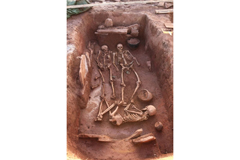 RUSSIA: The 2,500-year-old tomb of a Scythian warrior couple was uncovered in Siberia’s Khakassia region. The man and woman, who were members of the Tagar culture, were both buried with bronze weapons, including daggers and axes. While long-range arms such as bows and arrows are common in female Tagarian graves, this woman’s assemblage of hand-to-hand combat weapons is unusual and may attest to her fighting prowess. The couple was interred with an elderly woman—perhaps a servant—and an infant.
RUSSIA: The 2,500-year-old tomb of a Scythian warrior couple was uncovered in Siberia’s Khakassia region. The man and woman, who were members of the Tagar culture, were both buried with bronze weapons, including daggers and axes. While long-range arms such as bows and arrows are common in female Tagarian graves, this woman’s assemblage of hand-to-hand combat weapons is unusual and may attest to her fighting prowess. The couple was interred with an elderly woman—perhaps a servant—and an infant. -
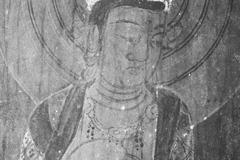 JAPAN: Infrared cameras have captured hidden Buddhist paintings obscured beneath centuries of soot on columns at the Saimyoji Temple, 40 miles northeast of Kyoto. The images of 8 religious icons, which are impossible to see with the naked eye, can be viewed in detail using the imaging technology. Based on the compositions’ style, researchers believe they may date to the later Asuka period (A.D. 492–710).
JAPAN: Infrared cameras have captured hidden Buddhist paintings obscured beneath centuries of soot on columns at the Saimyoji Temple, 40 miles northeast of Kyoto. The images of 8 religious icons, which are impossible to see with the naked eye, can be viewed in detail using the imaging technology. Based on the compositions’ style, researchers believe they may date to the later Asuka period (A.D. 492–710).
Advertisement
IN THIS ISSUE
Features
Top 10 Discoveries of 2020
Top 10 Discoveries of the Decade
Return to the River
Letter from Woodhenge
Digs & Discoveries
Reading, Writing, and Algorithms
Face Off
Formatting Bronze Age Tablets
Cat's Eye View
The Bone Collector
Who Is That Masked God?
Persian Steel
Head Space
Offerings at Sea
Bathing With the Toad Goddess
Off the Grid
Around the World
Peopling the Caribbean, Scythian warrior couple, dogs of the First Nations, and a stonemason’s inside joke
Artifact
Praying inside the box
Advertisement

Recent Issues
-
 May/June 2024
May/June 2024
-
 March/April 2024
March/April 2024
-
 January/February 2024
January/February 2024
-
 November/December 2023
November/December 2023
-
 September/October 2023
September/October 2023
-
 July/August 2023
July/August 2023
-
 May/June 2023
May/June 2023
-
 March/April 2023
March/April 2023
-
 January/February 2023
January/February 2023
-
 November/December 2022
November/December 2022
-
 September/October 2022
September/October 2022
-
 July/August 2022
July/August 2022
-
 May/June 2022
May/June 2022
-
 March/April 2022
March/April 2022
-
 January/February 2022
January/February 2022
-
 November/December 2021
November/December 2021
-
 September/October 2021
September/October 2021
-
 July/August 2021
July/August 2021
-
 May/June 2021
May/June 2021
-
 March/April 2021
March/April 2021
-
 January/February 2021
January/February 2021
-
 November/December 2020
November/December 2020
-
 September/October 2020
September/October 2020
-
 July/August 2020
July/August 2020
-
 May/June 2020
May/June 2020
-
 March/April 2020
March/April 2020
-
 January/February 2020
January/February 2020
-
 November/December 2019
November/December 2019
-
 September/October 2019
September/October 2019
-
 July/August 2019
July/August 2019
-
 May/June 2019
May/June 2019
-
 March/April 2019
March/April 2019
-
 January/February 2019
January/February 2019
-
 November/December 2018
November/December 2018
-
 September/October 2018
September/October 2018
-
 July/August 2018
July/August 2018
-
 May/June 2018
May/June 2018
-
 March/April 2018
March/April 2018
-
 January/February 2018
January/February 2018
-
 November/December 2017
November/December 2017
-
 September/October 2017
September/October 2017
-
 July/August 2017
July/August 2017
-
 May/June 2017
May/June 2017
-
 March/April 2017
March/April 2017
-
 January/February 2017
January/February 2017
-
 November/December 2016
November/December 2016
-
 September/October 2016
September/October 2016
-
 July/August 2016
July/August 2016
-
 May/June 2016
May/June 2016
-
 March/April 2016
March/April 2016
-
 January/February 2016
January/February 2016
-
 November/December 2015
November/December 2015
-
 September/October 2015
September/October 2015
-
 July/August 2015
July/August 2015
-
 May/June 2015
May/June 2015
-
 March/April 2015
March/April 2015
-
 January/February 2015
January/February 2015
-
 November/December 2014
November/December 2014
-
 September/October 2014
September/October 2014
-
 July/August 2014
July/August 2014
-
 May/June 2014
May/June 2014
-
 March/April 2014
March/April 2014
-
 January/February 2014
January/February 2014
-
 November/December 2013
November/December 2013
-
 September/October 2013
September/October 2013
-
 July/August 2013
July/August 2013
-
 May/June 2013
May/June 2013
-
 March/April 2013
March/April 2013
-
 January/February 2013
January/February 2013
-
 November/December 2012
November/December 2012
-
 Sep/Oct 2012
Sep/Oct 2012
-
 September/October 2012
September/October 2012
-
 July/August 2012
July/August 2012
-
 May/June 2012
May/June 2012
-
 March/April 2012
March/April 2012
-
 January/February 2012
January/February 2012
-
 November/December 2011
November/December 2011
-
 September/October 2011
September/October 2011
-
 July/August 2011
July/August 2011
-
 May/June 2011
May/June 2011
-
 March/April 2011
March/April 2011
-
 January/February 2011
January/February 2011
Advertisement






